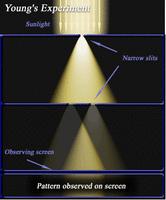Thomas Young performed his famous double slit experiment which seemed to prove that light was a wave. This experiment had profound implications, determining most of nineteenth century physics and resulting in several attempts to discover the ether, or the medium of light propagation. Though the experiment is most notable with light, the fact is that this sort of experiment can be performed with any type of wave, such as water. For the moment, however, we'll focus on the behavior of light.
What Was the Experiment?
In the early 1800's (1801 to 1805, depending on the source), Thomas Young conducted his experiment. He allowed light to pass through a slit in a barrier so it expanded out in wave fronts from that slit as a light source (under Huygens' Principle). That light, in turn, passed through pair of slits in another barrier (carefully placed the right distance from the original slit). Each slit, in turn, diffracted the light as if they were also individual sources of light. The light impacted an observation screen. This is shown to the right.
When a single slit was open, it merely impacted the observation screen with greater intensity at the center and then faded as you moved away from the center. There are two possible results of this experiment
Particle interpretation: If light exists as particles, the intensity of both slits will be the sum of the intensity from the individual slits.
Wave interpretation: If light exists as waves, the light waves will have interference under the principle of superposition, creating bands of light (constructive interference) and dark (destructive interference).
When the experiment was conducted, the light waves did indeed show these interference patterns. A third image that you can view is a graph of the intensity in terms of position, which matches with the predictions from interference.
Impact of Young's Experiment
At the time, this seemed to conclusively prove that light traveled in waves, causing a revitalization in Huygen's wave theory of light, which included an invisible medium, ether, through which the waves propagated. Several experiments throughout the 1800s, most notably the famed Michelson-Morley experiment, attempted to detect the ether or its effects directly.
They all failed and a century later Einstein's work in the photoelectric effect and relativity resulted in the ether no longer being necessary to explain the behavior of light. Again a particle theory of light took dominance.
Expanding the Double Slit Experiment
Still, once the photon theory of light came about, saying the light moved only in discrete quanta, the question became how these results were possible. Over the years, physicists have taken this basic experiment and explored it in a number of ways......

-
UP 0 DOWN 0 0 2

2 Answers
btw there is another old video..
you may want to have a look at this one...
[url=http://targetiit.com/videos/double-slit-experiment/]YDSE Video[/url]